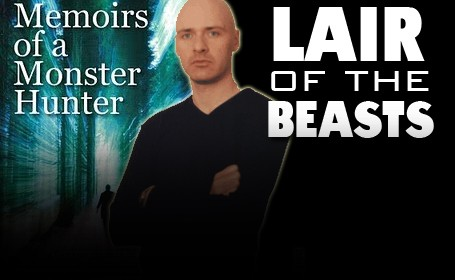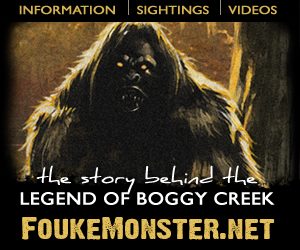Bigfoot: What About the Food?
Posted by: Nick Redfern on March 11th, 2013

Over at Mania.com, there’s a new Lair of the Beasts article from me that focuses on one aspect of the Bigfoot mystery that has always intrigued me – the matter of what it eats…
Here’s how the article begins:
“Many researchers of the Bigfoot phenomenon take the view that the hairy, man-like beasts are some form of unknown ape. Or, they suggest that the creatures may represent a surviving, relic population of the presumed long-extinct, ancient ape known as Gigantopithecus, I, however, do not. Rather, I take the stance that Bigfoot is stranger than either of the above scenarios; in fact, much stranger. Indeed, it’s fair to say I think Bigfoot is a beast of paranormal – rather than flesh and blood – origins. There’s a good reason I say that. It has to do with Bigfoot’s eating habits. Or, more correctly, it’s lack of eating habits.”
And here’s where you can find the complete post, and where those who believe Bigfoot is a flesh-and-blood animal, and nothing else, can comment, vent their fury at my words, wave their arms, and burn me in effigy.
About Nick Redfern
Punk music fan, Tennents Super and Carlsberg Special Brew beer fan, horror film fan, chocolate fan, like to wear black clothes, like to stay up late. Work as a writer.










OK, I burned you in effigy.
Summing up:
There is loads and loads of reportage on what sasquatch eat. They have been observed eating, foraging, hunting and carrying presumable food on many, many occasions. In fact the first ape for which meat eating was recorded – about a century before its documentation in chimps – was the sasquatch.
Unsurprisingly, sasquatch appear to eat many of the same things eaten by other big temperate omnivores, specifically: bears. Intelligence, bipedalism, speed and hands allow them to specialize in ways that make resource conflicts an insignificant issue.
After all…there is LOTS out there to eat.
@DWA: This might be too O/T, but I was playing around with the idea of thinking about Sasquatch as ecologically similar to not only bears, but also coyotes and raccoons- as omnivores and opportunists that actually thrive on the periphery of industrial human civilizations. Think of coyotes, they were aggressively driven back by rural farmers, but as the farms became mechanized, the people left the countryside; left the farms, stopped roaming the forest with shotguns, and instead kept to the roads and cities.
Whereas a coyote in 1900 might have a hard time of things, with all the competition from hunters and ranchers protecting their livestock, a coyote nowadays gets to feast upon overpopulated deer, roadkill, and garbage. Might the Sasquatch be in a similar boom time? Nearly driven to extinction from the abrupt expansion of the US 1800-1950, but since thriving as the US rural population retreats into the cities, leaving the immense waste of industrial agriculture in its wake?
This might suggest a workable line of research: figure out how the bears, coyotes, and raccoons are adapting to the new industrialized ecosystem, use that data to focus your field work, and hope to find a Sasquatch amidst all the bears.
Oh….^^^^on topic, Mr. McKellar. And food for thought. While we’re on food.
There is certainly enough foodstuff on the continent, enough to support 30 million deer, some 2 million moose and elk, and about a million bears. Grasses, nuts and seeds, flowers, fruits, and berries. No shortage of foodstuff for herbivores or omnivores.
If Sasquatch exits, it is likely eating the same food sources that deer, moose and bears are.
And there are reports involving Sasquatch taking various foodstuff from peoples’ properties. Again, if it exists, it consumes food.
Adding the paranormal to this phenomenon achieves nothing other than making a already controversial subject even more controversial.
For everyone who has commented on this matter so far, my answer is: so what?
I recommend you go back and read the article. Here’s why: we have comments above about coyotes, bears, deer, moose etc.
That clearly means you are looking to North American cases as to why Bigfoot is NOT paranormal.
However, here’s the important thing: my words in my article are focused ONLY on Bigfoot/hairy man-beasts in the UK.
It’s no secret that I think the British Bigfoot is paranormal. But, equally, I’m sure Orang-Pendek is flesh and blood.
As a Brit, I can assure there is NOT enough food (never mind enough space) to feed entire colonies of giant apes in the UK. Plus, I’m not aware of a single case in the UK where a Bigfoot type creature has been observed eating.
The locations of such sightings are notable too – stone circles, old burial mounds, bridges, crossroads, cemeteries – locales that are famous for paranormal events.
If someone wants to argue that there is enough food for massive animals to live on in certain countries, that’s fine. But the UK – which is the entire thrust of my article – is not one of them.
Nick:
So what?
I didn’t open the link because most people won’t, and what is right on the front page doesn’t mention the UK, one time.
Besides which, Bigfoot is a NA beastie and there is no reason to believe there is anything like this in the UK.
OK, there could be centaurs there too.
But what is the evidence?
Insanity:
You say: “Adding the paranormal to this phenomenon achieves nothing other than making a already controversial subject even more controversial.”
Huh???? Are you saying we should avoid addressing controversy, just to keep cotroversy levels down?
If there is controversy, it should be addressed – even if that means adding more to the mix. We should never avoid addressing all avenues, controversial or not.
One other thing on this matter: while my article re food and Bigfoot was (as a careful reading of it will make clear) a study of the British beast, it’s true that my thoughts concerning Bigfoot in the US are near-identical.
But, in the US, that’s not so much based on food availability, but on the high-strangess reports, such as Bigfoot appearing and vanishing (literally), the Fortean overtones in some cases, the 1973/4 wave that Stan Gordon chronicles in his Silent Invasion book etc.
Most Bigfoot researchers probably deny or dismiss the high-strangeness stuff. I don’t, for one good reason. Bigfoot researchers note correctly that many eye-witnesses to Bigfoot are very credible, which is certainly true.
But, those same researchers then suggest the eye-witnesses to the high-strangeness stuff were mistaken, hoaxers, fantasists, etc.
If Bigfoot is ONLY a large, unknown ape then there shouldn’t be ANY high-strangeness. Instead, it should just be sightings of, and encounters with, an unknown animal and that’s all. But it’s this attendant weirdness that sometimes pops up in the US cases which leads me to believe that the flesh and blood ape isn’t the whole story.
Yes, I KNOW that the weird tales are in the minority, but the mere fact that they exist in the first place is reason enough to not ignore them.
Those of us who advocate avoiding the high strangeness do so for the following reasons.
1. There are no compelling reasons to consider any such activity any more than coincidental to the sighting of an animal.
2. “Compelling” means many, consistent, accounts that there is no reason to doubt on their face.
3. Science can’t – and won’t – test any of it.
4. The great body of the consistent evidence indicates an animal that leaves sign allowing it to be traced and documented.
If they shape-shift, let a group of scientists watching one confirm that.
Which will never happen if they’re not confirmed, which is extremely unlikely to happen if the high strangeness angle is prominent, because science won’t touch high strangeness, and there’s no compelling reason at this point that they should.
The problem with paranormal explanations is just that we just don’t know the first thing about how paranormal things actually work. Maybe the British bigfoots are the ghosts of long-dead druids, maybe they’re ET’s, maybe they’re secret military robots, who knows? How can we even try to research such things? Do ghosts like to eat? Do they leave footprints? Anything’s possible, but even the open-minded empiricist needs to start with what they know, and use that experience and information to find out more about what they don’t know. Since Bigfoot sightings in the US line up pretty well with bear sightings, and we already know a bunch about bears (as opposed to Fortean phenomenon), then researching might lead us to understand something new about Bigfoot.
Besides, if you switch out the coyotes and raccoons for foxes, the same sort of ecological change that is playing out in the US might also be playing out in Britain. Modern industrial society produces massive amounts of food, not just scattered allotments and farmer’s gardens but factories and tractor-trailers and supermarkets full of food, much (25%) of it completely wasted. I think that provides a great ecological opportunity for something smarter than your average bear. Recent sightings of big cats in the British Isles might be part of the same sort of ecological change, just as mountain lions in the US are re-establishing their ranges.
Just because a modern industrial human can’t find food in the countryside doesn’t mean its not there. The article mentioned that British Bigfoot sightings cluster around megalithic sites; those sites not too long ago supported large human populations mostly by forage, with only scant Neolithic farming going on.
This isn’t to say the paranormal stuff should be completely disregarded, just that we should start with what we know and understand, rather than using the paranormal as an excuse for our ignorance (e.g. we don’t know what they eat, so they must be paranormal). I would start by doing the Cultural Anthropology, documenting how the nearby human populations understand the paranormal, and then using those patterns and categories to make sense of paranormal bigfoot phenomenon. That kind of inquiry is very difficult and complicated (TM Luhrmann does it very well), but at least it tells you something about something, rather than pure speculation.
The deer population of the UK is over a million, is it not? Obviously there is food for them. How would there not be enough food for another large species? Most likely any Bigfoot equivalent is eating what the deers are, as well as possibly on the deer, and filtering out what they may be eating out of what is also being consumed by the deer would not be an easy task.
Closer to what I meant is that because you don’t understand what they may be feeding on, or that no sightings involve seeing them eating, doesn’t mean it’s paranormal.
All I can add to the last two comments is:
Right.
Science can start with what is known. But it’s gonna have to watch a lot of sasquatch disappear, orb out or become Tony Blair before getting a clue.
Why not just look for an animal that leaves footprints?
Now if you don’t have those…or anything else physical…just how many of these reports are there?
There is now published DNA evidence from the U.S. and Russia. So clearly, according to Fernie’s analysis, that must be paranormal DNA. Give me a break, fellah. Try and keep up with the latest research. Oh, I get it: having traveled here from another dimension and having had sex with the local women–like those who eat leprecaun food–they are now trapped here in this dimension.